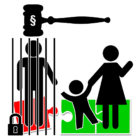
California Is Becoming a Model of Juvenile Justice Reform, Thanks to Progressive Legislation
|
California has evolved from having one of the most draconian, costly juvenile justice systems to becoming a model of reform.
Juvenile Justice Information Exchange (https://jjie.org/page/88/)

In late September, Torri was driving down the highway with her 11-year-old son Junior in the back seat when her phone started ringing.
It was the Hamilton County Sheriff’s deputy who worked at Junior’s middle school in Chattanooga, Tennessee. Deputy Arthur Richardson asked Torri where she was. She told him she was on the way to a family birthday dinner at LongHorn Steakhouse.
“He said, ‘Is Junior with you?’” Torri recalled.
Earlier that day, Junior had been accused by other students of making a threat against the school. When Torri had come to pick him up, she’d spoken with Richardson and with administrators, who’d told her he was allowed to return to class the next day. The principal had said she would carry out an investigation then. ProPublica and WPLN are using a nickname for Junior and not including Torri’s last name at the family’s request, to prevent him from being identifiable.
When Richardson called her in the car, Torri immediately felt uneasy. He didn’t say much before hanging up, and she thought about turning around to go home. But she kept driving. When they walked into the restaurant, Torri watched as Junior happily greeted his family.
Soon her phone rang again. It was the deputy. He said he was outside in the strip mall’s parking lot and needed to talk to Junior. Torri called Junior’s stepdad, Kevin Boyer, for extra support, putting him on speaker as she went outside to talk to Richardson. She left Junior with the family, wanting to protect her son for as long as she could ...

California has evolved from having one of the most draconian, costly juvenile justice systems to becoming a model of reform.

Restorative justice is a centuries-old approach that seeks to empower people to address the harms, needs and obligations that arise when a crime has been committed by bringing together victims, offenders and members of their respective communities.

Is it possible to educate youth in the adult criminal justice system? As Marshall Project reporter Eli Hager recently observed, “In the U.S., there is adult jail and there is school, and the two rarely go together.”

Medical sociologist Eric Wright’s work has taken him into parks, abandoned buildings, shelters and other places off the beaten path.

They’re on our streets. In our schools and colleges. They’ve probably taken your fast-food order. But you wouldn’t know it.

Congress reauthorized a key juvenile justice bill today, handing a win to youth advocates who have fought to update the legislation for more than a decade.
The House backed the Senate’s version of the bill Thursday morning, sending it to the White House for President Donald Trump to sign. The Senate unanimously approved a five-year reauthorization of the Juvenile Justice and Delinquency Prevention Act (JJDPA) on Tuesday night using a fast-track procedure that requires the support of every senator.

This year has been one of the most transformative years in history for New York’s juvenile justice system. Just a month after one of New York’s most groundbreaking juvenile justice reforms, Raise the Age, became a reality, New York City took a wrecking ball to the decades-old Spofford Juvenile Detention Centers in the Bronx.

As the holiday season rolls around and many of us are cherishing time with those we love, families separated by incarceration continue to face barriers when trying to maintain a sense of support and connection with their loved ones.